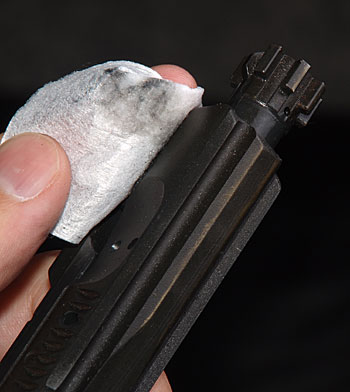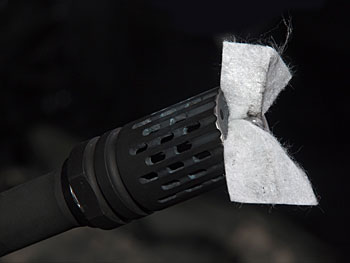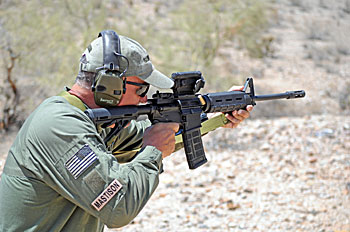
Over the last decade it seems that the expansion of the AR market has managed to put a black rifle in the safe of every serious gun owner in the country. My carbine classes have seen a dramatic increase in popularity with AR’s being the most common weapon. One of the areas I get the most questions on in these classes centers on the maintenance of the AR. Maintenance is equally important for the tactical hunting crowd. Imagine spotting that big boar you’ve been looking for. You take aim, wait for the right angle, when all is right, you pull the trigger. Nothing. The bolt wasn’t all the way forward. The noise you make to get it chambered alerts the hog to your presence and it’s gone. Or worse your shot is less than perfect and now the hog is charging and you have a failure to feed.
The AR platform has as many detractors as it has fans, but is still rapidly becoming America’s number one hunting rifle, especially with tactical hog hunters.. One of the biggest “complaints” I hear is the rifle is not reliable because it is a direct impingement system. Essentially it uses spent gasses to run the bolt. I will not get into a debate on many of the myths surrounding this, but will instead focus on what I suggest as a cleaning and maintenance program. This is not a “how to” but rather a “when to” with some suggestions on specifics.
The most important thing people need to know is that these weapons need to be kept lubricated to run effectively. As I see more and more people entering training classes, I find many of them have a “Glock” mind. The Glock mind is one that is not aware of how critical lube is on a gun. These folks are cutting their teeth on guns that claim to need little to no lube, and that carries over to their other weapons as well. I would even go so far as to say that many Glocks are under-lubricated. I realize that Gaston Glock just started twitching so I will leave that discussion for another day.
More times than not, reliability issues have much more to do with lubrication and springs than it does with “cleanliness” of the gun. Bad extractor springs, magazines and buffer springs are the major culprit. But, this is about cleaning so let’s get into that.
 I recommend that people use two cleaning protocols. This consists of a general cleaning and a complete break down cleaning. The general cleaning is done after every range session. This essentially includes running a bore snake down the barrel, wiping the bolt carrier off, wiping the entire rifle down and lubricating.
I recommend that people use two cleaning protocols. This consists of a general cleaning and a complete break down cleaning. The general cleaning is done after every range session. This essentially includes running a bore snake down the barrel, wiping the bolt carrier off, wiping the entire rifle down and lubricating.
The second cleaning I recommend is when the rifle hits the 5000 round mark. This number could be more or less depending on the ammo you run and the environment you train in, so use it as an average. If you are running ammo with corrosive primers, or surplus ammo, you need to keep a closer eye on your blaster. A complete cleaning consists of disassembling the rifle and breaking the bolt down. Use the cleaner of your choice on the barrel and run patches though it until they run clean. On the bolt and carrier, you should use a carbon cleaner and carbon removal tool. Be very careful about using this tool however. Your goal is to remove the carbon build up without damaging the surface or finish of the metal surfaces. Inspect all surfaces and springs. Check the gas rings, and makes sure you take time to use some compressed air to blow out the trigger group. Thoroughly lubricate the rifle and reassemble.
A question I get often is, “Can I over clean my rifle?” Well, it has less to do with it being super clean than it does about wear and tear on the gun. Many people are very aggressive in their cleaning and that in and of itself can cause problems. The less you have to take something apart, the better the parts will continue to fit. Being over zealous about cleaning can cause excessive and unnatural wear which will lead to reliability issues.
 I will once again beat the lubrication drum. A dirty weapon that is well lubricated will almost always run while a dry and dirty gun will fail. If you are having issues with your well lubricated AR, I would look at springs and magazines as the primary problem.
I will once again beat the lubrication drum. A dirty weapon that is well lubricated will almost always run while a dry and dirty gun will fail. If you are having issues with your well lubricated AR, I would look at springs and magazines as the primary problem.
There are endless options in the lube world. I use a couple that have served me well. For a wet lube I use Militec, and for grease I use TW-25B. I like the TW-25B because it is long lasting. This is especially true on belt-fed and crew served weapons. Wet lube is much more field expedient, however, so the Militec is a standard part of my load out.
Whether your favorite black rifle is a range gun, a trainer, a home defense gun, a zombie apocalypse blaster, or your tactical hog hunting platform, cleaning it has as much to do with extending its life as it does anything else. Excessive carbon causes pitting and wear on metal parts. Be reasonable and keep an eye on it. Until we meet again, be safe, stay in the hunt, and stay in the fight!

